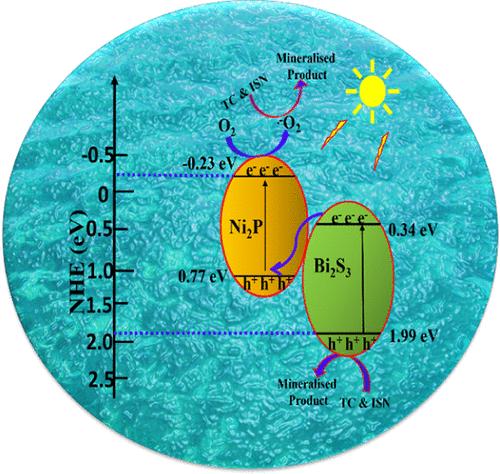Bi2S3修饰金属-有机骨架衍生Ni2P:一种用于抗生素可见光降解的高效Z-Scheme异质结
IF 3.9
3区 工程技术
Q2 ENGINEERING, CHEMICAL
引用次数: 0
摘要
鉴于人们对广泛使用抗生素所引发的环境问题日益关注,开发有效的方法来消除制药废水中的抗生素残留物是非常必要的。光催化已成为一种重要的高级氧化技术,具有满足这些需求的巨大潜力,从而引发了半导体光催化剂研究的热潮。在此,我们报告了一种通过直接 Z 型光催化系统对 Ni2P-Bi2S3 异质结构进行强定制的方法,用于高效、选择性地光催化降解四环素(TC)和异烟肼(ISN)。目前的异质结具有多种优势,如有效的电荷转移途径、高效的电荷分离、延长的光诱导电荷载流子寿命以及增强的氧化还原电位。光催化实验表明,Ni2P-Bi2S3 异质结对 TC 和 ISN 的降解效率分别达到 93.8% 和 90.2%,约为原始材料的两倍。进行了捕集实验,结果表明 -O2- 是主要的活性氧物种。此外,根据 LC-MS 确认的降解产物,提出了 TC 和 ISN 的光催化降解途径。Ni2P-Bi2S3 异质结具有良好的回收性能和出色的稳定性。这些发现为开发用于降解抗生素和有机污染物的高效、可回收光催化剂提供了巨大的潜力。本文章由计算机程序翻译,如有差异,请以英文原文为准。

Metal–Organic Framework-Derived Ni2P Decorated on Bi2S3: A Highly Efficient Z-Scheme Heterojunction for Visible Light Photodegradation of Antibiotics
Given the growing concerns about environmental issues stemming from widespread antibiotic use, developing effective methods to eliminate antibiotic residues from pharmaceutical wastewater is critically necessary. Photocatalysis has emerged as a crucial advanced oxidation technology with significant potential to meet these needs, igniting a surge in research on semiconductor photocatalysts. Herein, we report a robust tailoring of Ni2P–Bi2S3 heterostructures via a direct Z-scheme photocatalytic system for highly efficient and selective photocatalytic degradation of tetracycline (TC) and isoniazid (ISN). The current heterojunction offers several advantages, such as an effective charge transfer pathway, efficient charge separation, prolonged photoinduced charge carrier lifetimes, and enhanced redox potential. Photocatalytic experiments demonstrate that the Ni2P–Bi2S3 heterojunction achieves degradation efficiencies of 93.8% for TC and 90.2% for ISN, approximately twice that of the pristine materials. Trapping experiments were conducted, and the results indicate •O2– as the dominant reactive oxygen species. Furthermore, the photocatalytic degradation pathway of TC and ISN was proposed based on degradation products confirmed by LC-MS. The Ni2P–Bi2S3 heterojunction shows good recovery properties and excellent stability. These findings hold significant potential for developing efficient and recyclable photocatalysts for the degradation of antibiotics and organic pollutants.
求助全文
通过发布文献求助,成功后即可免费获取论文全文。
去求助
来源期刊

Industrial & Engineering Chemistry Research
工程技术-工程:化工
CiteScore
7.40
自引率
7.10%
发文量
1467
审稿时长
2.8 months
期刊介绍:
ndustrial & Engineering Chemistry, with variations in title and format, has been published since 1909 by the American Chemical Society. Industrial & Engineering Chemistry Research is a weekly publication that reports industrial and academic research in the broad fields of applied chemistry and chemical engineering with special focus on fundamentals, processes, and products.
 求助内容:
求助内容: 应助结果提醒方式:
应助结果提醒方式:


